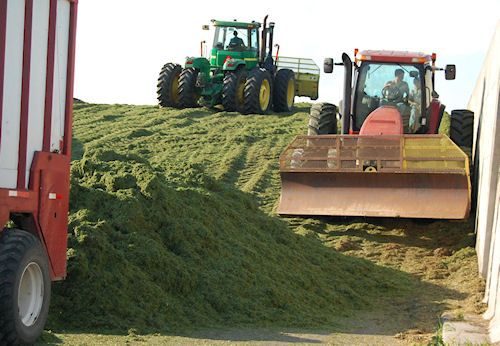Corn Silage Harvest: Setting Yourself up to Succeed in 2017
Posted: August 17, 2016 | Written By: Tim Kinches, Form-A-Feed Nutrition and Production Specialist

What is the best way to set yourself up to succeed in 2017? Make great forage in 2016. Nothing you will do after making corn silage in 2016 will bring you more profitability than focusing on great corn silage today. Making corn silage is much more than just chopping. Planning for great silage starts today.
There is so much information about how to make great silage but let’s try to make it a little easier and basic.
Step 1- Planning: Everyone that is going to have anything to do with harvesting corn silage needs to be on the same page and have a plan. What fields are we going to chop first? At what moisture levels do we adjust the chopper length and processor? What are we going to do if we hit a really dry or wet patch in a field?
Step 2- Execution: Once you start, the goal is to get done as fast as possible but because everyone is rushing, we need to have a system to monitor the quality during the organized chaos. Checking processing score and dry matter is a must. Everyone knows that dry matter of the corn silage is important but constantly checking processing score is vitally important too. You can use a Penn State Box to check for whole kernels, but did you know you can use a tub of water to check processing score? Ask your local Form-A-Feed representative to show you. I suggest processing score is checked every morning and afternoon as well as every time someone new is running the chopper. Do not forget a good inoculant, such as SileTech should be applied during harvest to speed up fermentation and reduce dry matter loss. Only a 2% savings in dry matter loss will pay for the cost of an inoculant.
Step 3- Packing: The key to packing is packing. Sounds simple right? Harvested feed should be pushed up in layers of six to ten inches and drove over multiple times. The tractors pushing feed needs to do more than just push feed. If you push up feed in small layers and then back down the pile to push-up more feed, you are not packing enough. Remember the easy thumb rule: 800 lbs. of tractor for every ton/hour you harvest. If it is a complete drive-over pile a slope of 3:1 on the sides is vital. So for every one foot of rise you should see three feet of length of the side wall. Too steep, and the pressure of the tractor is forced down the side of the pile and not vertically down the inside of the pile. If you are putting silage in a bag, then the bag should be smooth, tight and no lumps.
Step 4- Covering: Covering a pile ASAP does not mean in two days. It needs to be done that night or the next morning. Tires need to be added to the top of the plastic so that all tires are touching.
Step 5- Waiting: Try to let the silage sit until Jan 1, 2017. Fermentation will be done much sooner than this date but there is much research that will show digestibility of starch and fiber will continue to change for three to four months after silage is harvested. I always recommend that you plan on harvesting enough silage for 15 months.
Ask your local Form-A-Feed representative for more detailed information about how your farm can make the best forage possible. And remember, please, during harvest, be SAFE.